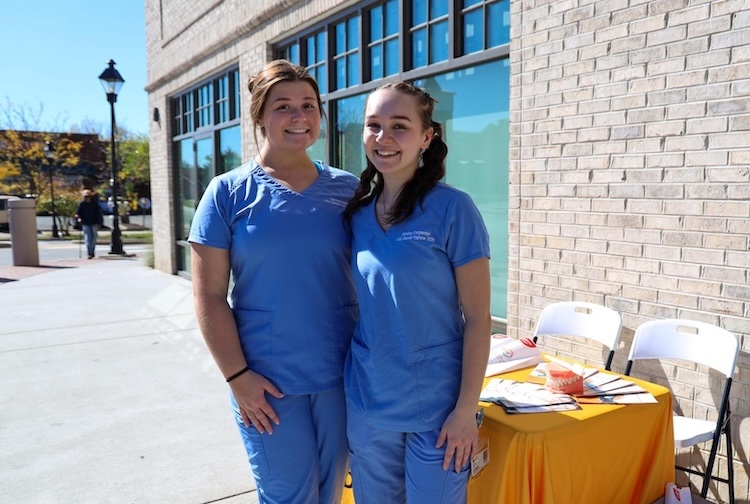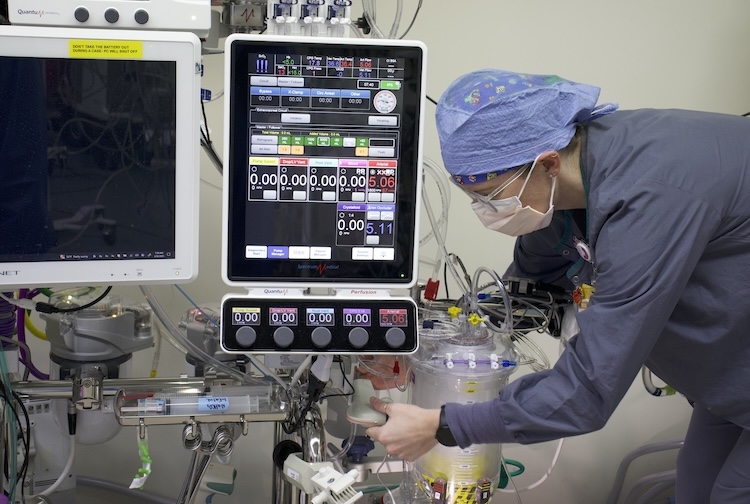‘When I started, I felt ready’: How nontraditional students found medicine as a second career
While their journey was different, these VCU students found community through a common destination – becoming physicians.
October 28, 2025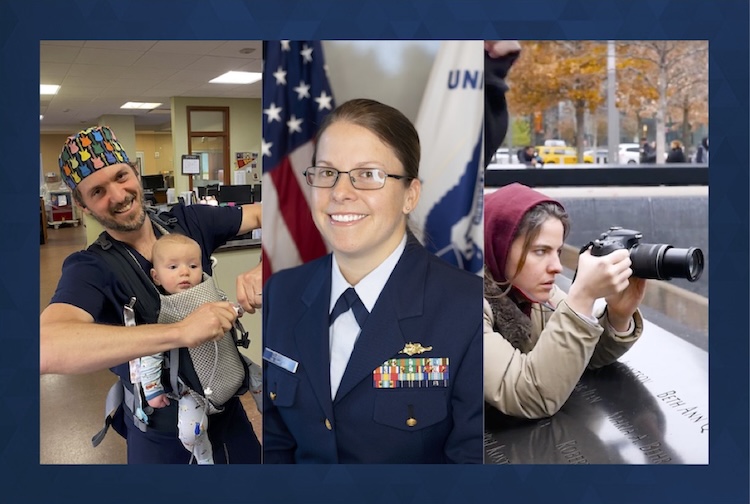 Bradley Sheffield, Jayme Dubinsky and Julie Kraft (from left) are training at the VCU School of Medicine as nontraditional students. (Contributed photos)
Bradley Sheffield, Jayme Dubinsky and Julie Kraft (from left) are training at the VCU School of Medicine as nontraditional students. (Contributed photos)
By Grace McOmber
When new medical students arrive on the MCV Campus, they bring more than grades and MCAT scores. They also bring the personal and professional life experiences that have shaped them into the students they are today.
According to a national survey of incoming medical students in 2024, 74% had taken at least a year between undergraduate and medical school, the highest percentage to date. For many, that time is used to enhance their qualifications, complete pre-med requisite courses, or just take time for themselves before jumping back into academics.
For others, a longer gap signifies the years they spent in a career prior to starting their medical training, sometimes in an entirely unrelated field. And at the Virginia Commonwealth University School of Medicine, students with diverse professional experiences are invaluable in shaping a well-rounded medical student class.
“Nontraditional students provide a unique perspective based on their prior work and life experiences,” Chris Woleben, M.D., associate dean of admissions, said. “Since so much of the School of Medicine’s curriculum is taught using a small group approach, the collective experiences of all students help to enrich the learning environment, which eventually leads to improved patient care and outcomes.”
From an electrical engineer to an emergency room nurse, these nontraditional students are bringing a different perspective to medicine and finding community in their common goals.
“I was worried that I’d have nothing in common with other students, or that it would feel strange hanging out with people who are quite a bit younger than me,” said Bradley Sheffield, a second-year medical student in his 30s. “But that really vanished when I got to school, because we are all just people working hard toward a similar goal. We have a lot more in common than I thought.”
Jayme Dubinsky: Finding purpose
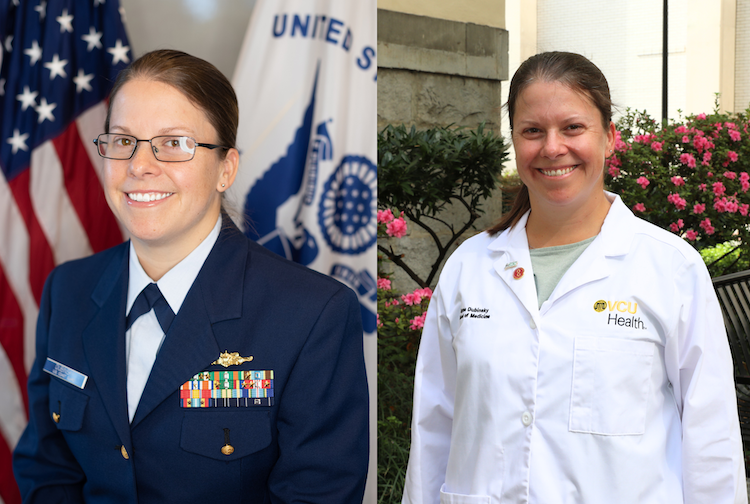
Jayme Dubinsky served in the U.S. Coast Guard for 20 years before starting medical school this year. (Contributed photo/Arda Athman, School of Medicine)
For 20 years, Jayme Dubinsky lived, worked and served on the water. But when she considered what life would look like after being an electrical engineer in the U.S. Coast Guard, it was her favorite hobby on land that led her to medicine.
An avid trail runner and nature enthusiast, Dubinsky first considered becoming a park ranger and took a wilderness emergency medicine class to prepare. With a certification in hand and a new assignment in Washington, D.C., Dubinsky began volunteering as an EMT at a nearby county fire and rescue department, which sparked an unexpected interest.
“Working with patients for the first time really opened my eyes, but when you pick someone up for transport, you only get to know them a little bit,” Dubinsky said. “I wondered about what happened to those patients after they were dropped off.”
Dubinsky's interest in building long-lasting relationships with her future patients led her to consider family medicine as a specialty and enroll in the Family Medicine Scholars Training and Admission, a dual-admission program for aspiring primary care physicians. Dubinsky sees herself working in a rural setting in the future, filling the need for more primary care providers and partaking in the same hobby that introduced her to medicine -- trail running.
“With family medicine, you get to follow people throughout their lives and really get to know them,” said Dubinsky, a first-year medical student at VCU. “I have so much to learn, but I want to be a physician that patients feel comfortable talking to.”
Julie Kraft: Where art meets science
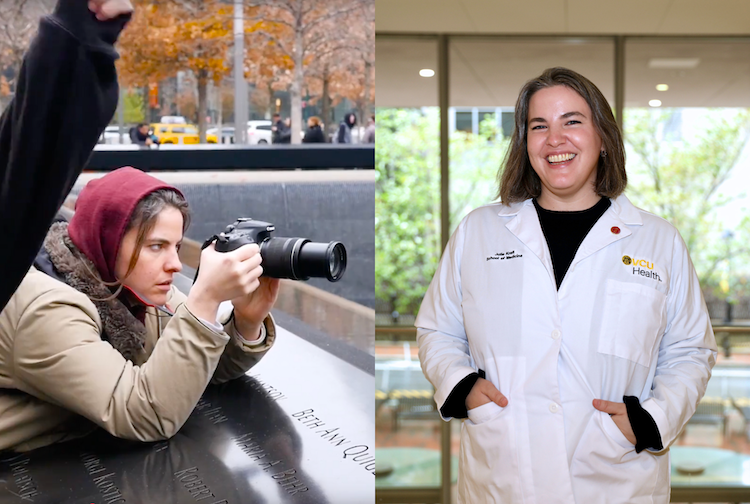
Julie Kraft worked as a photographer and documentary video editor in New York City prior to starting medical school. (Contributed photo/Arda Athman, School of Medicine)
Medicine had always been in the back of Julie Kraft’s mind as a career option. But when she graduated from New York University in 2016, she didn’t feel ready to begin school again and was “a little intimidated” by the training. Kraft, who’s originally from Richmond, chose to stay in New York City to pursue another of her interests — photography.
For years, Kraft captured New York through a camera lens, working as a production assistant for documentarians, organizing and editing their footage. On the side, she worked as a freelance photographer, covering art exhibitions around the city for local magazines.
It was while photographing one of these events, an art exhibition on the unethical experimentation on enslaved women by 19th century gynecologist J. Marion Sims, that Kraft realized she was ready to pursue medicine. She was moved by the use of art to explore the complex history of medicine, and the experience sparked a desire to pursue a health care career grounded in empathy, integrity and service.
“Documentary and photography are often about telling someone else’s story. You have to be able to ask the right questions or get the right shot to accurately tell that story,” Kraft said. “Those listening and problem-solving skills are important in medicine, too, because a lot of it is learning someone’s life story and finding out how to help them.”
As she transitioned from photography to a pre-medical track, Kraft applied those skills while working with marginalized communities at public health organizations throughout New York City. In these settings, she saw the “immediate positive impacts” health care providers had on patients and the ways health care and advocacy intersect.
“It was so enlightening to see what a collaborative team of doctors, nurses, case managers, front desk workers and volunteers looks like and what it can achieve,” Kraft said. “Being that voice of affirmation for patients can be so powerful.”
Kraft’s journey led her back to Richmond for a master’s degree in the Department of Neuroscience and Anatomy at the School of Medicine and the school’s premedical graduate health sciences certificate program to further prepare herself for the next four years of education. Since beginning her training earlier this year, Kraft said she is grateful for her experiences outside of medicine, and how they have shaped her as a student.
“I feel a lot more prepared to juggle my life with school in a way I probably wouldn’t have been able to when I was younger,” Kraft said. “I see school is just a part of my life now, rather than my entire life.
Bradley Sheffield: Translating experience
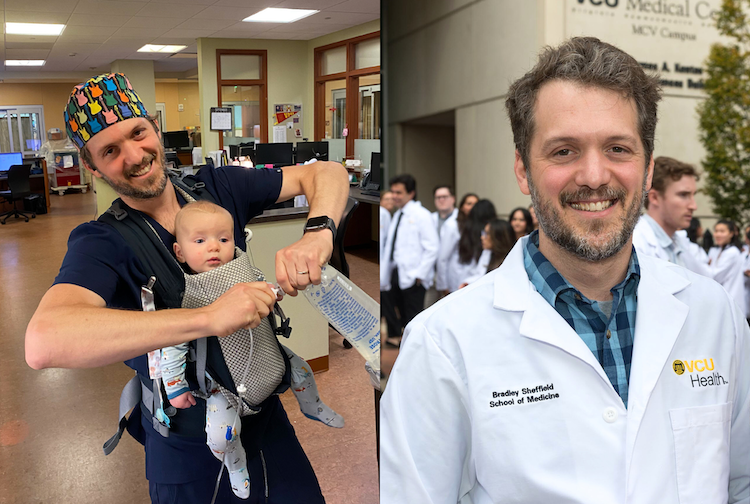
In between exams and lectures, Bradley Sheffield picks up shifts as an emergency room nurse. (Contributed photo/Arda Athman, School of Medicine)
Medical school is the latest chapter in a career serving others for Bradley Sheffield. He spent 15 years working with adults with developmental disabilities, accompanying them to doctor’s appointments and advocating on their behalf. But when the time came for a career switch, Sheffield landed on nursing, initially seeing it as an opportunity to continue helping others.
“When I got to nursing school, I was surprised by how interested I was in the scientific aspects of that education,” Sheffield said. “I felt that I could see myself continuing my training and going further in this field.”
Sheffield enjoyed the medical side of nursing so much that he enrolled in premedical requisite courses while still completing nursing school, and just weeks after passing the NCLEX, the licensure exam for nurses, he sat for the MCAT. Now a second-year student in the School of Medicine, Sheffield still picks up a couple of nursing shifts a month in the emergency room at Martha Jefferson Hospital in Charlottesville, where he is eager to apply his new knowledge and skills from medical school.
“I feel like I better understand everything that’s going on and can translate that to patients,” Sheffield said. “The ER is very overwhelming, so being able to give patients some reassurance is really helpful.”
Working in a clinical environment as a pre-clinical medical student is also giving Sheffield a look into his future. He said he enjoys seeing a variety of cases and is interested in pursuing internal medicine, a field that offers an average of 20 subspecialties.
Since starting medical school, he has also found an interest in research and is currently on a project investigating inequity in access to pulmonary fibrosis treatment. In the future, Sheffield said he hopes to use his position as a physician scientist to advocate for patients and health care reform on a larger scale.
“I spent the beginning of my career on the ground, seeing first-hand how many structural hurdles there are for adults with developmental disabilities,” Sheffield said. “As a physician, I hope to use research to effect the change I know needs to happen.”
A version of this story was originally published by VCU School of Medicine


